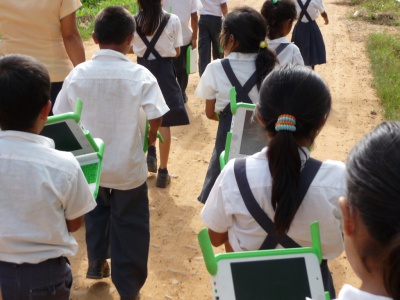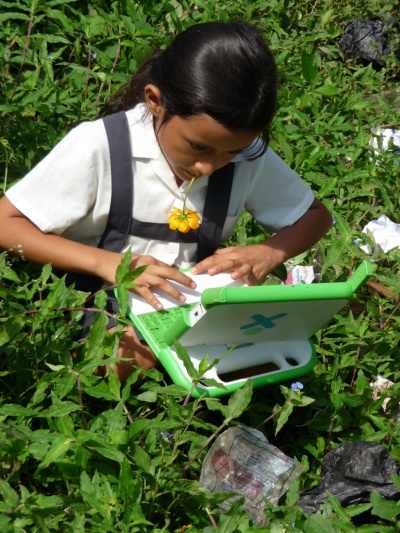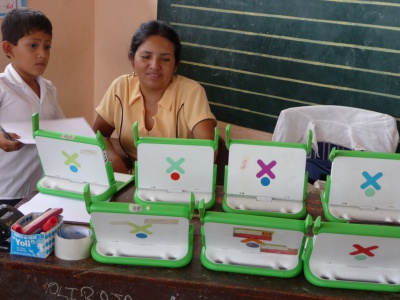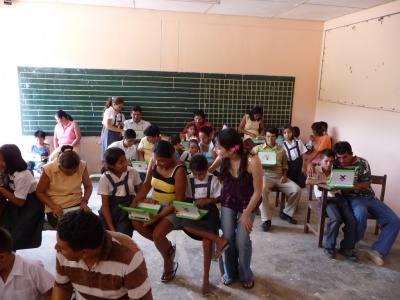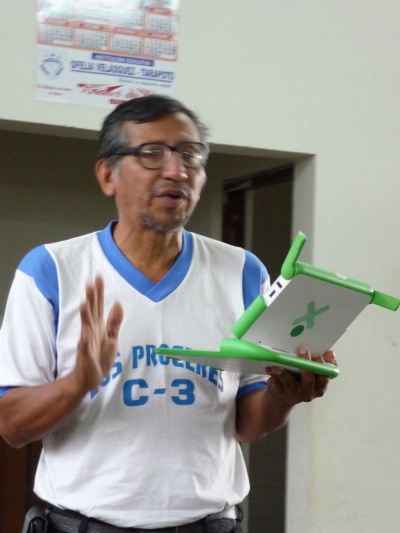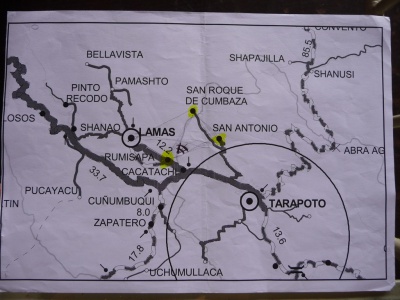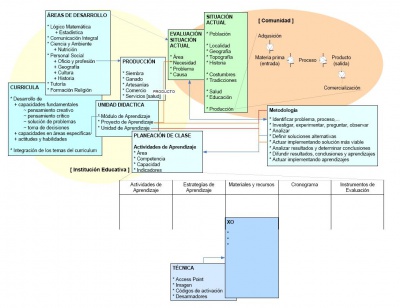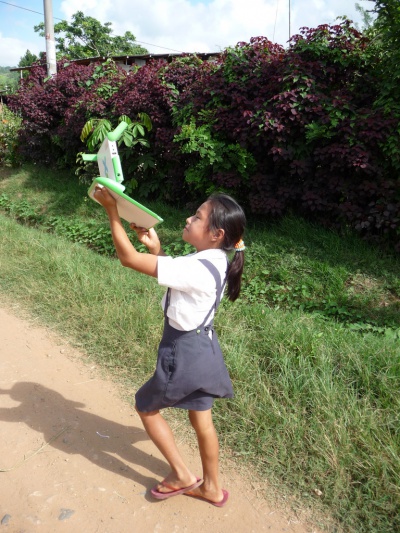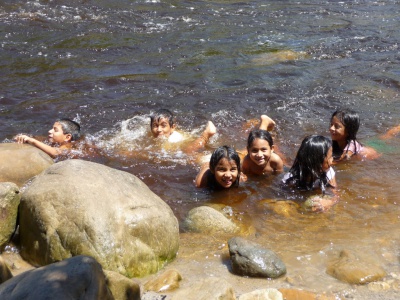Participative Community: Difference between revisions
| (7 intermediate revisions by the same user not shown) | |||
| Line 8: | Line 8: | ||
'''List of projects:''' |
'''List of projects:''' |
||
RU SP SR : Plagues: bats |
|||
l : Plagues affecting yucca (cassava), bananas, citrics,...) |
|||
RU SP SR : Lack of drinkable water (SR 4) |
|||
RU : Malnutrition (RU 3 & 4) |
|||
RU SP SR : Alcoholism (SP 5 & 6 |
|||
RU SR : Intra-family violence (SR 1) |
|||
RU SP : Sewage |
|||
RU SP SR : Commercialization of Products (RU 5 & 6) |
|||
SR : Deforestation (SP 1 & 2) |
|||
SR : Lack of employment (SR 2) |
|||
RU SR : Security (RU 1) |
|||
RU : Garbage (RU 2) |
|||
RU SP SR : Technical Advice - COCOA (SR 5 & 6) |
|||
RU SP SR : XO training for Parents (SP 3 & 4) |
|||
SR : Teacher Training |
|||
SR : Lack of electricity (many children live in the fields) |
|||
SR : Teachers don't teach well |
|||
{| class="wikitable" |
|||
RU = '''Rumipasa'''. It's a four classroom school. Third and fourth grades work together, as do fifth and sixth. It's the closest to Tarapoto City and to Lamas UGEL. The school just received a satellite dish and wireless Internet. 79 students in total. The community is rural but still better well off than the others, given it's proximity to the city. The teachers proved to be very committed and worked nicely as a team. |
|||
|- |
|||
SP = '''San Pedro'''. It's a three classroom school. All the teachers teach two grades. It's about 30 minutes away from the city on unpaved road. It's mainly agricultural. The principal did not seem very committed to education. The school does not have Internet. |
|||
! RU |
|||
SR = '''San Roque'''. It's an integrated school: kindergarten, primary and secondary school are taught within the same institution. Only primary students have a laptop, though in breaks secondary students borrow them to chat on Chat activity. The village is mainly agricultural; it’s high up in the hills, beautiful scenery. It's an hour away from Tarapoto, not easily accesible. Half of the teachers leave in nearby towns. Teachers were not very motivated about educating. |
|||
! SP |
|||
! SR |
|||
! Description |
|||
|- |
|||
| RU |
|||
| SP |
|||
| SR |
|||
| Plagues: bats |
|||
|- |
|||
| 1 |
|||
| |
|||
| |
|||
| Plagues affecting yucca (cassava), bananas, citrics,...) |
|||
|- |
|||
| RU |
|||
| SP |
|||
| SR |
|||
| Lack of drinkable water (SR 4) |
|||
|- |
|||
| RU |
|||
| |
|||
| |
|||
| Malnutrition (RU 3 & 4) |
|||
|- |
|||
| RU |
|||
| SP |
|||
| SR |
|||
| Alcoholism (SP 5 & 6) |
|||
|- |
|||
| RU |
|||
| |
|||
| SR |
|||
| Intra-family violence (SR 1) |
|||
|- |
|||
| RU |
|||
| SP |
|||
| |
|||
| Sewage |
|||
|- |
|||
| RU |
|||
| SP |
|||
| SR |
|||
| Commercialization of Products (RU 5 & 6) |
|||
|- |
|||
| |
|||
| |
|||
| SR |
|||
| Deforestation (SP 1 & 2) |
|||
|- |
|||
| |
|||
| |
|||
| SR |
|||
| Lack of employment (SR 2) |
|||
|- |
|||
| RU |
|||
| |
|||
| SR |
|||
| Security (RU 1) |
|||
|- |
|||
| RU |
|||
| |
|||
| |
|||
| Garbage (RU 2) |
|||
|- |
|||
| RU |
|||
| SP |
|||
| SR |
|||
| Technical Advice - COCOA (SR 5 & 6) |
|||
|- |
|||
| RU |
|||
| SP |
|||
| SR |
|||
| XO training for Parents (SP 3 & 4) |
|||
|- |
|||
| |
|||
| |
|||
| SR |
|||
| Teacher Training |
|||
|- |
|||
| |
|||
| |
|||
| SR |
|||
| Lack of electricity (many children live in the fields) |
|||
|- |
|||
| |
|||
| |
|||
| SR |
|||
| Teachers don't teach well |
|||
|- |
|||
|} |
|||
RU = '''Rumipasa'''. |
|||
<br> |
|||
It's a four classroom school. Third and fourth grades work together, as do fifth and sixth. It's the closest to Tarapoto City and to Lamas UGEL. The school just received a satellite dish and wireless Internet. 79 students in total. The community is rural but still better well off than the others, given it's proximity to the city. The teachers proved to be very committed and worked nicely as a team. |
|||
<br> |
|||
SP = '''San Pedro'''. |
|||
<br> |
|||
It's a three classroom school. All the teachers teach two grades. It's about 30 minutes away from the city on unpaved road. It's mainly agricultural. The principal did not seem very committed to education. The school does not have Internet. |
|||
<br> |
|||
SR = '''San Roque'''. |
|||
<br> |
|||
It's an integrated school: kindergarten, primary and secondary school are taught within the same institution. Only primary students have a laptop, though in breaks secondary students borrow them to chat on Chat activity. The village is mainly agricultural; it’s high up in the hills, beautiful scenery. It's an hour away from Tarapoto, not easily accesible. Half of the teachers leave in nearby towns. Teachers were not very motivated about educating. |
|||
== Schools: == |
== Schools: == |
||
| Line 36: | Line 122: | ||
== Projects: == |
== Projects: == |
||
Following there are three descriptions of the kind of projects teacher worked on. |
|||
===Garbage=== |
===Garbage=== |
||
| Line 127: | Line 214: | ||
:Wed 3<sup>rd</sup> Rumisapa. |
:Wed 3<sup>rd</sup> Rumisapa. |
||
:Thur 4<sup>th</sup> San Pedro. |
:Thur 4<sup>th</sup> San Pedro. |
||
:Fri 5<sup>th</sup> San Roque: Led a Scratch exploring session with all the primary |
:Fri 5<sup>th</sup> San Roque: Led a Scratch exploring session with all the primary school children while teachers had a meeting. |
||
:Tues 9<sup>th</sup> Rumisapa: parents’ XO laptop training session. Parents had to come with their children. Children guided their parents through the activities. |
|||
school children while teachers had a meeting. |
|||
:Tues 9<sup>th</sup> Rumisapa: parents’ XO laptop training session. Parents had to come |
|||
with their children. Children guided their parents through the activities. |
|||
:Wed 10<sup>th</sup> San Pedro and visited San Juan school, which also received XO laptops |
:Wed 10<sup>th</sup> San Pedro and visited San Juan school, which also received XO laptops |
||
:Thur 11<sup>th</sup> San Roque. |
:Thur 11<sup>th</sup> San Roque. |
||
| Line 154: | Line 239: | ||
They are multi-level primary schools in jungle communities. Children start their end-of-school year vacation on 12 December; teachers continue going till the 19th, and clases re-start in March 2009. |
They are multi-level primary schools in jungle communities. Children start their end-of-school year vacation on 12 December; teachers continue going till the 19th, and clases re-start in March 2009. |
||
[[Image:P1010287.JPG|thumb| |
[[Image:P1010287.JPG|thumb|400px|[[Image:P1010287.JPG|actual size]]|center|map]] |
||
==
Methodology == |
==
Methodology == |
||
| Line 161: | Line 245: | ||
This first stage of the project will help teachers and principals design the 2009 Annual Plan, based on children's learning needs as well as on community issues. |
This first stage of the project will help teachers and principals design the 2009 Annual Plan, based on children's learning needs as well as on community issues. |
||
[[Image:Mapa1.jpg|thumb| |
[[Image:Mapa1.jpg|thumb|400px|[[Image:Mapa1.jpg|actual size]]|center|plan]] |
||
Each teacher worked on a project chosen from a list made by the parents in the three communities. The aim was to get the teachers to develop the project together with the children, based on every afternoon's work. |
Each teacher worked on a project chosen from a list made by the parents in the three communities. The aim was to get the teachers to develop the project together with the children, based on every afternoon's work. |
||
| Line 188: | Line 272: | ||
On my second and last visit to San Pedro, to a primary school with three classrooms. The principal, Mr. R., hadn't come to school. His students in 1st and 2nd grades were by themselves in their classroom, some with their laptops on and some were just playing. |
On my second and last visit to San Pedro, to a primary school with three classrooms. The principal, Mr. R., hadn't come to school. His students in 1st and 2nd grades were by themselves in their classroom, some with their laptops on and some were just playing. |
||
[[Image:P1010426. |
[[Image:P1010426.JPG|thumb|400px|[[Image:P1010426.JPG|actual size]]|center|playing]] |
||
I asked one of the other two teachers if I could work with the children and also asked the children if they wanted me to learn with them. I asked what subjects they had to go into that day; besides Science and Environment, Math-Logic, and P.E, we also did Art, Integral Communication, and Social Person. I looked in my little notebook to see what project had been chosen by their teacher in our afternoon sessions. Mr. R had chosen Deforestation. I asked the children if they had talked about it. They said “no”. They had never heard of the term before. We defined it with the things they were familiar with, and some of their conclusions were that without plants, we will die and animals too. They painted on Scratch how they would like their surroundings to be, and also did simple animations. P was a first grader who understood how to use Scratch right away, and besides helping others, he started adding more and more characters to his story. Among his characters he had a bat, so we started working in parallel with my bat-project. |
I asked one of the other two teachers if I could work with the children and also asked the children if they wanted me to learn with them. I asked what subjects they had to go into that day; besides Science and Environment, Math-Logic, and P.E, we also did Art, Integral Communication, and Social Person. I looked in my little notebook to see what project had been chosen by their teacher in our afternoon sessions. Mr. R had chosen Deforestation. I asked the children if they had talked about it. They said “no”. They had never heard of the term before. We defined it with the things they were familiar with, and some of their conclusions were that without plants, we will die and animals too. They painted on Scratch how they would like their surroundings to be, and also did simple animations. P was a first grader who understood how to use Scratch right away, and besides helping others, he started adding more and more characters to his story. Among his characters he had a bat, so we started working in parallel with my bat-project. |
||
| Line 196: | Line 280: | ||
It was hot, and a few children on their way back got some popsicle, local candy, gum, or a soda. I sponsored a Popsicle for each one (0.10 Soles each). And after the children calculated how much we had to pay the lady and how much money she had to give us back, we sat in the plaza to eat our icy-thing and do mental math. We started by adding “what if besides buying the popsicle for each one, we had also gotten a piece of gum like M?” So M gave us the price of the gum and then everybody else did the math. Then we added a soda for each one, and then we calculated getting the change after paying with different coins. After we finished adding so much stuff, L said that buying junk food was very expensive. It was easy for the children to do the mental math related to sweet treats and getting the correct change. We went back to school because it was recess time. The sixth graders came by and started learning from P how to do animations on Scratch. But the group wanted to start the P.E. session as soon as possible. On our way to the P.E. field (beyond a few houses) we picked R up, a 4 year old boy with Down’s syndrome. When we got to the field, everybody chose to do swimming lessons rather than play volleyball or doing other exercises. So they did swim. R took lots of photos of them, and the camera kept on getting stuck because R was far to fast with his clicking technique, though he got good shots. P had to swim with his shirt on since he had lots of chicken pox scabs all over and the sun was really strong, but he didn't want to stay outside the river with us. |
It was hot, and a few children on their way back got some popsicle, local candy, gum, or a soda. I sponsored a Popsicle for each one (0.10 Soles each). And after the children calculated how much we had to pay the lady and how much money she had to give us back, we sat in the plaza to eat our icy-thing and do mental math. We started by adding “what if besides buying the popsicle for each one, we had also gotten a piece of gum like M?” So M gave us the price of the gum and then everybody else did the math. Then we added a soda for each one, and then we calculated getting the change after paying with different coins. After we finished adding so much stuff, L said that buying junk food was very expensive. It was easy for the children to do the mental math related to sweet treats and getting the correct change. We went back to school because it was recess time. The sixth graders came by and started learning from P how to do animations on Scratch. But the group wanted to start the P.E. session as soon as possible. On our way to the P.E. field (beyond a few houses) we picked R up, a 4 year old boy with Down’s syndrome. When we got to the field, everybody chose to do swimming lessons rather than play volleyball or doing other exercises. So they did swim. R took lots of photos of them, and the camera kept on getting stuck because R was far to fast with his clicking technique, though he got good shots. P had to swim with his shirt on since he had lots of chicken pox scabs all over and the sun was really strong, but he didn't want to stay outside the river with us. |
||
[[Image:P1010778.JPG|thumb| |
[[Image:P1010778.JPG|thumb|400px|[[Image:P1010778|actual size]]|center|photo taken by R: Swimming lesson in the river]] |
||
| Line 204: | Line 288: | ||
The XOs don't come to school every day |
The XOs don't come to school every day |
||
== Acknowledgments: == |
== Acknowledgments: == |
||
| Line 224: | Line 306: | ||
* Maria for spending her only Sunday in Lima explaining to me the Peruvian Educational Methodology for me to be able to map it within the Participative Community Phase, and for the long phone conversations on how to approach diverse issues regarding the teachers’ and the Ministry of Education’s usual ways of doing things. |
* Maria for spending her only Sunday in Lima explaining to me the Peruvian Educational Methodology for me to be able to map it within the Participative Community Phase, and for the long phone conversations on how to approach diverse issues regarding the teachers’ and the Ministry of Education’s usual ways of doing things. |
||
* Oscar for being so positive and for always finding opportunities in all the challenges, and for letting us learn with them. |
* Oscar for being so positive and for always finding opportunities in all the challenges, and for letting us learn with them. |
||
* Jedierikb for editing. |
|||
* OLPC - for everything else. |
* OLPC - for everything else. |
||
Latest revision as of 14:49, 17 December 2008
Text and Photos by Carla Gomez Monroy, OLPC
16 December 2008
In our first visit to each of the schools, first thing in the morning a parents’ session was organized. Besides explaining the purpose of the Participative Community Phase, we brainstormed with them the community’s issues: needs, problems, areas to improve,… as well as the coming and going to school with the OLPC XO laptop. These is a list of the issues they outlined:
List of projects:
| RU | SP | SR | Description |
|---|---|---|---|
| RU | SP | SR | Plagues: bats |
| 1 | Plagues affecting yucca (cassava), bananas, citrics,...) | ||
| RU | SP | SR | Lack of drinkable water (SR 4) |
| RU | Malnutrition (RU 3 & 4) | ||
| RU | SP | SR | Alcoholism (SP 5 & 6) |
| RU | SR | Intra-family violence (SR 1) | |
| RU | SP | Sewage | |
| RU | SP | SR | Commercialization of Products (RU 5 & 6) |
| SR | Deforestation (SP 1 & 2) | ||
| SR | Lack of employment (SR 2) | ||
| RU | SR | Security (RU 1) | |
| RU | Garbage (RU 2) | ||
| RU | SP | SR | Technical Advice - COCOA (SR 5 & 6) |
| RU | SP | SR | XO training for Parents (SP 3 & 4) |
| SR | Teacher Training | ||
| SR | Lack of electricity (many children live in the fields) | ||
| SR | Teachers don't teach well |
RU = Rumipasa.
It's a four classroom school. Third and fourth grades work together, as do fifth and sixth. It's the closest to Tarapoto City and to Lamas UGEL. The school just received a satellite dish and wireless Internet. 79 students in total. The community is rural but still better well off than the others, given it's proximity to the city. The teachers proved to be very committed and worked nicely as a team.
SP = San Pedro.
It's a three classroom school. All the teachers teach two grades. It's about 30 minutes away from the city on unpaved road. It's mainly agricultural. The principal did not seem very committed to education. The school does not have Internet.
SR = San Roque.
It's an integrated school: kindergarten, primary and secondary school are taught within the same institution. Only primary students have a laptop, though in breaks secondary students borrow them to chat on Chat activity. The village is mainly agricultural; it’s high up in the hills, beautiful scenery. It's an hour away from Tarapoto, not easily accesible. Half of the teachers leave in nearby towns. Teachers were not very motivated about educating.
Schools:
The schools are in the jungle of Peru, not too far from the city, though Rumisapa is the nearest and has the best road.
Projects:
Following there are three descriptions of the kind of projects teacher worked on.
Garbage
“Mi comunidad sin suciedad “ - My community without dirt --project developed by Rumisapa's second grade teacher and her students
Miss C took the XO laptop training in Chiclayo. It was one of the first trainings, in which the Ministry of Education consultants were training teachers and regional specialists. Compared with her fellows, she was more advanced on the XO usage.
Miss C worked hard through the week and accomplished lots. She had chosen “garbage” from the list of parents’ needs list to work on that with her students. Besides preparing her Project-based planning and framing it within a Unit-based planning (Peruvian pedagogical methodology), she also developed every single Class-Planning based on the subjects she had to work on every day, and relating them to her project. Children collaborated on developing the Garbage-project planning. Miss C developed the chronogram and the activities. On Friday 5th, children discussed their knowledge of Garbage and all its related issues; some even mentioned the common places in the village where garbage could be seen. Monday was a national holiday.
On Tuesday 9th, children went outside after planning their field trip. Some parents came along. Children taught their parents how to take photos with their XOs. Four sites in the village where visited, all of them where just a field where garbage was dumped. The first site, had just burned all their garbage, (children think that someone let that family know about the visit ahead of time). One of them is the place where the school disposes of its garbage, and the playground, which is very close to the school. In the playground the group stayed talking about the different kinds of garbage they had seen and smelled, the possible effects, and ways to prevent that from happening. Also, responsibilities of the citizens and authorities regarding the garbage. They developed their cleaning campaign,... Children did surveys about how much garbage people waist per day, and they did calculations on how much garbage is produced per day in the whole community, per month, per year,... they also did some graphics. They used the laptop for most of the activities, though they also used pencil, notebook, recycled materials. Also children made a printed awareness message, with which they went house by house knocking on doors and explaining to the inhabitants about the garbage problem, and left the small piece of paper. They all went and cleaned together the playground and placed some garbage bins around it.
Message to the neighbors:
ESTIMADO VECINOS RUMISAPINOS LOS ESTUDIANTES DEL 2° GRADO DE LA I.E. NIVEL PRIMARIA 0285 DE NUESTRA LOCALIDAD, TRABAJAMOS UN PEQUEÑO PROYECTO DENOMINADO “Mi comunidad sin suciedad “ PARA ELLO RECORRIMOS LUGARES COMO LA QUEBRADA CHUPISHIÑA, EL PARQUE, LA PLAZA PRINCIPAL, EL COLEGUO, EL CAMPO DE FUTBOL, TERRENOS ABANDONADOS Y PUDIMOS CONSTATAR QUE EN ESTOS LUGARES, EXISTE BASURA, ES DECIR NO SE LE DA EL LUGAR CORRESPONDIENTE A LOS DESHECHOS. AMIGO RUMISAPINO SI NO TIENES RELLENO SANITARIO EN TU DOMICILIO CONSTRUYELO : NO CONTAMINES EL CHUPISHIÑA. SI FRECUENTAS LA PLAZA, EL PARQUE , EL CAMPO DE FUTBOL Y LLEVAS COMIDA, FRUTAS, GASEOSAS Y OTROS NO BOTES BASURA EN EL SUELO, PONLE EN EL TACHO, SINO HAY, LLEVA UN RECIPIENTE O GUÁRDALO EN TU BOLSILLO.
Comercialization of Local Products
" Organizados produciremos y venderemos mejor" – Organized, we will produce and sell better. project developed by Rumisapa's fifth and sixth grade teacher and her students
Miss L was the principal of the school. She has many years of experience. She chose the Comercialization of Local Products as her project. As soon as she chose it, she said “I have no clue about it”. She developed her Project-based and class-activies planning together with her students. She was amazed on how much the children knew about their parents’ issues on selling the products, on possible ways to improve and the many different areas that the problem was related to.
Children mentioned that when their parents take their products to the market in Tarapoto, sometimes the buyers want to buy it very cheap. Since the peasant doesn't know the market price, they sell them. Other times, the buyer gives them fake money, or their scales are purposely wrongly calibrated to the disadvantage of the peasant. To sell products peasants have to arrive very early, around 4 AM, to the market, and transportation is scarce and not cheap, among many other products related to growing the products, storing them, purchasing supplies, weather changes, etc.
Some children started sharing strategies and coming up with new ones. One little girl said that whenever she can, she goes to the market with her parents, and she goes around asking the prices of the products they are trying to sell, once she got a sense of the daily price, then the parents start selling.
They did a survey to parents and the people around the community, though people who were interviewed did not want to be recorded, so they had to take notes in their notebooks rather than with their laptop. They called for a community meeting to work with the experienced people of the town about their problem. However since school is in the morning, and peasants work in the field in the morning, not many people came, though those who came had insightful knowledge.
Children organized a product fair in twon, they announced it over the town megaphone, and by telling people around. They collected products from their family productions, and they chose a strategic place in town where they could sell their products. Children came on Thursday monirng, the day of the fair, with big amounts of fruits and local production and some big bananas among them. Children sold at convenient prices their products since it was an awareness campaign. However, they sold everything they had brought to the fair.
Children identified the importance of growing and selling the products in an organized (as a village) manner and on the simple ways that they could prevent been scammed, also about fertilizers and insecticides. Better techniques to grow plants, like grafting so the fruit resists more the journey to the selling point, and better ways to collect it.
Alcoholism
"To alcoholism say NO, to sports say YES.” project developed by San Pedro's fifth and sixth grade teacher and her students
Miss M. Was new at the school and never attended any training about the laptop, though she had experience teaching. She learned quickly how to use some of the activities and integrated them to her project. Children did surveys around town asking how much alcohol people consume per day. They also visited the local stores and asked about the amounts they sell per day, peak days, and seasons. The effects in the body and in the family.... They did math calculations and graphing in Turtle Art. They invited parents to play a soccer match. While playing, children took photos of the game and afterwards the teacher introduced the topic to the parents.
Children wrote and drew a letter to their parents that will be given on Christmas, about Christmas being a season to rejoice, about the importance of being there for the family and how important it was for them to have their parents not getting drunk on such a day.... Letter which was related to Jesus Christ being born as part of their Religion class.
Phase II: Participative Community
Role Map
- Friday 21st November 2008. Decided to go back to Peru to work on developing a second phase of the deployment of XO laptops in the neediest Peruvian schools.
- Friday 21st to Wednesday 26th. Conceptualized the project, did traveling logistics, got a visa and a new passport, and traveled to Peru.
In collaboration with the Ministry of Education:
- Thursday 27th to Sunday 30th. Framed the project within the Peruvian educational methodology (tons of reading on my part), chose the three schools to work with (in Rumisapa, San Pedro, and San Roque villages), did traveling logistics, prepared technical and pedagogical materials, coordinated with principals and regional specialists for the venues, sessions, and school visits.
- Monday 1st December 2008. Worked on logistics, schedule, agenda, and traveled to Tarapoto.
- Tuesday 2nd to Friday 5th and from Tuesday 9th to Thursday 11th December 2008.
- Mornings. Visited the schools to meet with the parents, supported the teachers in class activities with the children, worked on broken cases of laptops, batteries, software and chargers.
- Tues 2nd Visited the three schools, one in each of the three villages.
- Wed 3rd Rumisapa.
- Thur 4th San Pedro.
- Fri 5th San Roque: Led a Scratch exploring session with all the primary school children while teachers had a meeting.
- Tues 9th Rumisapa: parents’ XO laptop training session. Parents had to come with their children. Children guided their parents through the activities.
- Wed 10th San Pedro and visited San Juan school, which also received XO laptops
- Thur 11th San Roque.
- Afternoons. Met with the teachers to work on project based work, on how to work on community projects within their educational methodology, on specific class activities, and on how to use the XO laptop as a tool to foster community projects and get products and results that could be better achieved with the XOs or not be achieved otherwise. Teachers commented every afternoon on their morning experiences, and every afternoon they were assigned some homework: objective and subjective evaluations and instruments, defining their project based work regarding their community needs, framing it within their educational goals, planning and developing the project and each of the activities for their classes, per area and across areas. These hands-on community projects were planned and realized from Thursday 4th till Thursday 11th, date on which they presented all their products, experiences, and frameworks.
- Sunday 7th and Monday 8th December 2008. Guidance sessions on XO laptop activities with the teachers. In teachers' homes.
- Friday 12th December 2008. Worked in Lima with the Ministry of Education, especially with the Tech Team to get a better overall idea of their technical challenges.
- End of school year.
- Monday 2th March 2009. Beginning of school year.
- In 2009, teachers will continue with the 2nd Phase: Participative Community.
School selection
The schools were selected based on the following criteria: areas where XO laptops had been received and where the lowest academic achievements had been reported, where community based work would be relevant, where at least one school out of a group had Internet connection, and where communities were reachable within 30-to-60 minutes from a city. Rumisapa village had gotten satellite connection the day before I arrived. Aided by a map, two more schools that looked really close to Rumisapa and to each other, forming a triangle, were included.
They are multi-level primary schools in jungle communities. Children start their end-of-school year vacation on 12 December; teachers continue going till the 19th, and clases re-start in March 2009.
Methodology
This first stage of the project will help teachers and principals design the 2009 Annual Plan, based on children's learning needs as well as on community issues.
Each teacher worked on a project chosen from a list made by the parents in the three communities. The aim was to get the teachers to develop the project together with the children, based on every afternoon's work.
Teachers were very motivated and enthusiastic about the project based work, with community involvement and impact. And the students enjoyed the learning experience much more.
It concluded with teachers presenting the work carried out during the workshop. Teachers closed by presenting their projects, the work done with children and communities and with their digital products. Representatives of the local educational entities and the president of the local parents’ association joined the presentations.
Challenges:
Little time and busy season: Classes finished on December 12th, teachers attended, participated and worked hard on developing their projects for the afternoon sessions and in the mornings with their students and communities, regardless of the evaluations they had to do, paperwork they had to fill out, and end-of-year plays and 6th grade graduation ceremonies they had to set up and rehearse. And all this in spite of only getting a day’s notice about our workshops in afternoon sessions.
Health:
- Conjunctivitis was widespread in the community of San Roque; many children and grown-ups were affected, and some in San Pedro, and even the Director of the San Martin UGEL (a local MoE branch).
- Chicken pox. One child came to school with chicken pox.
- Got bitten by too many mosquitoes.
A school day with 1st and 2nd graders
On my second and last visit to San Pedro, to a primary school with three classrooms. The principal, Mr. R., hadn't come to school. His students in 1st and 2nd grades were by themselves in their classroom, some with their laptops on and some were just playing.
I asked one of the other two teachers if I could work with the children and also asked the children if they wanted me to learn with them. I asked what subjects they had to go into that day; besides Science and Environment, Math-Logic, and P.E, we also did Art, Integral Communication, and Social Person. I looked in my little notebook to see what project had been chosen by their teacher in our afternoon sessions. Mr. R had chosen Deforestation. I asked the children if they had talked about it. They said “no”. They had never heard of the term before. We defined it with the things they were familiar with, and some of their conclusions were that without plants, we will die and animals too. They painted on Scratch how they would like their surroundings to be, and also did simple animations. P was a first grader who understood how to use Scratch right away, and besides helping others, he started adding more and more characters to his story. Among his characters he had a bat, so we started working in parallel with my bat-project. After approaching nature in such an artistic way, we went outside to take pictures of our surroundings and things that could be hazardous and provoke deforestation. Children took their XO laptops with them and started taking photos of nice representations of nature: flowers, trees, animals; some representative constructions of their village: the church, a house, the plaza; also some threats: garbage on the ground, bat excrement; and some of the people who were significant to them: the kindergarten teacher and her students. We discussed the bat problem; they said that bats are really noisy at sunset and don't let people by when they’re on their way home, that they could make people sick, that they eat plants and animals, and even bite humans and turn them into vampires. When I asked for a physical description of bats, P told me that they were exactly like the ones in his early ‘Kitten’-activity (Scratch) story. We went to the Medical Center to talk to the nurse, but the center was closed, and talking to some people that were waiting outside, we were told that all the dark thick powder on the ground around the Medical Center was the ‘poop’ of the bats. The children took some quick photos and we went away quickly. Then the children wanted to visit the kindergarten and take pictures of the kindergarten teacher and her students because they also had the same problems with bat poop in the kindergarten. So, after asking the teacher for permission, the children took photos and videos of the little fellows. And after we explained the purpose of our field trip, the teacher and the little children sang a song about animals, plants and nature for us. Afterwards a big group picture was taken with all the children and the teacher. It was hot, and a few children on their way back got some popsicle, local candy, gum, or a soda. I sponsored a Popsicle for each one (0.10 Soles each). And after the children calculated how much we had to pay the lady and how much money she had to give us back, we sat in the plaza to eat our icy-thing and do mental math. We started by adding “what if besides buying the popsicle for each one, we had also gotten a piece of gum like M?” So M gave us the price of the gum and then everybody else did the math. Then we added a soda for each one, and then we calculated getting the change after paying with different coins. After we finished adding so much stuff, L said that buying junk food was very expensive. It was easy for the children to do the mental math related to sweet treats and getting the correct change. We went back to school because it was recess time. The sixth graders came by and started learning from P how to do animations on Scratch. But the group wanted to start the P.E. session as soon as possible. On our way to the P.E. field (beyond a few houses) we picked R up, a 4 year old boy with Down’s syndrome. When we got to the field, everybody chose to do swimming lessons rather than play volleyball or doing other exercises. So they did swim. R took lots of photos of them, and the camera kept on getting stuck because R was far to fast with his clicking technique, though he got good shots. P had to swim with his shirt on since he had lots of chicken pox scabs all over and the sun was really strong, but he didn't want to stay outside the river with us.
After 30 min, we headed back to school. One or two went quickly to their homes on our way back and changed. The others didn't want to go home and came back to school somewhat wet. I had to go visit the San Juan school, so we called it a day.
On my way out, I visited the other two teachers, and worked on a Turtle Art graphing issue with the 5th and 6th graders, who were working on the Alcoholism project.
The XOs don't come to school every day
Acknowledgments:
All my gratefulness to:
- the community members of Rumisapa, San Pedro and San Roque.
- the students of the three schools we worked with.
- the teachers of the three educational institutions who attended our afternoon sessions, regardless of their home location, who planned and carried out their projects with lots of enthusiasm, and enjoyed the intense weeks of community projects, collaborative learning, and deepening their XO laptop experience.
- the Peru Ministry of Education for all their support and willingness, teachings and opportunities.
- Marilu for visiting the schools with me the first week and for explaining in detail the Peruvian Educational Methodology to the teachers (Unit and Project based work), and for coordinating with the schools and local authorities.
- Patricia for working so hard on defining the project within the Ministry of Education framework.
- Jose Buleje (and his schools) for supporting us in Tarapoto with his experience, for setting up the Rumisapa access point, for allowing the afternoon sessions to take place in his classroom with a dedicated wireless connection, and for taking us on the first day to all the schools.
- Lalo for taking the calls when having technical issues, and for providing technical materials.
- Luggi for the airline ticketing.
- Mario for the access points paperwork.
- Maria for spending her only Sunday in Lima explaining to me the Peruvian Educational Methodology for me to be able to map it within the Participative Community Phase, and for the long phone conversations on how to approach diverse issues regarding the teachers’ and the Ministry of Education’s usual ways of doing things.
- Oscar for being so positive and for always finding opportunities in all the challenges, and for letting us learn with them.
- Jedierikb for editing.
- OLPC - for everything else.


